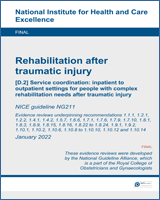
NCBI Bookshelf. A service of the National Library of Medicine, National Institutes of Health.
| Population | Quantitative |
|
|---|---|---|
| Qualitative |
| |
| Intervention/Phenomenonof interest | Quantitative |
|
| Qualitative |
Methods to coordinate and deliver rehabilitation services themselves and rehabilitation and social services in combination for children and young people when transferring from inpatient to outpatient rehabilitation services, regarded by the population as optimal/not optimal or effective/non-effective. Themes will be identified from the literature but may include:
| |
| Comparison | Quantitative |
|
| Qualitative | Not applicable. | |
| Outcomes | Quantitative |
|
| Qualitative | Themes will be identified from the literature but may include:
| |
| Context | Quantitative |
Rehabilitation and social care settings for patients with complex rehabilitation needs after traumatic injury Exclusion:
|
| Qualitative |
ADL: Activities of daily living; CHQ-CF80: Child Health Questionnaire self-report (adolescents aged 12-18 years); CHQ-PF-50: Child Health Questionnaire parent-report (children aged 5-18 years); COPM: Canadian occupational performance measure; E-ADL-Test: Erlangen Activities of Daily Living test; EURO-QoL 5D 3L; EuroQol 5 dimensions and 3 levels; FIMFAM: Functional independence measure and functional assessment measure; GAS: Goal attainment scaling; GP: General practitioner; MDT: Multi-disciplinary team; NHS: National Health Service; OARS: Older American resources and services scale; PAT: Performance ADL test; PEDS-QL: Pediatric Quality of Life Inventory; SENCO: Special Educational Needs Co-ordinator; SFMA; Selective functional movement assessment; SF-12: 12 item short-form survey; SF-36: 36 item short-form survey; SF-6D: 6-dimension shortform; TARN; Trauma Audit and Research Network

NCBI Bookshelf. A service of the National Library of Medicine, National Institutes of Health.